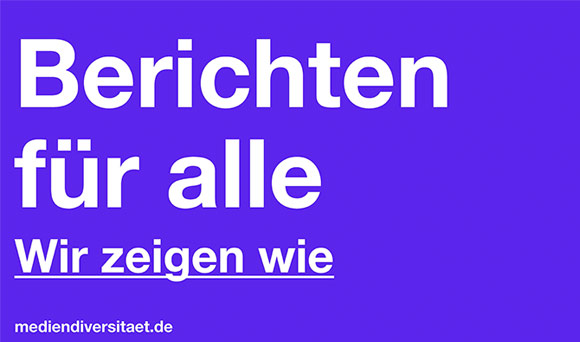ONLINE GUIDE FOR DIVERSITY IN THE MEDIA PUBLISHED

For the first time, an alliance of organizations has released recommendations, facts and checklists for intersectional diversity in the media. The joint publication by the New German Media Makers (Neue deutschen Medienmacher*innen, NdM), Leidmedien, the Lesbian and Gay Association in Germany, the MaLisa Foundation, ProQuote Medien and the Queer Media Society went online on December 7th.
A majority of people in Germany are neglected or excluded in German media,[1] including women, people with disabilities or with a migration background, BPoC or LGBTIQ*. Moreover, these people are usually underrepresented in editorial staff positions and are always underrepresented in leadership positions.[2] There are several distinguishing factors among these groups of people, and yet there are commonalities when it comes to discrimination as well as structural disadvantage in the media – especially because those affected frequently have several of these affiliations. For this reason alone, it is crucial not to view them separately from one another, but to set up intersectional strategies and steps for more diversity.
PProfessional media work is diverse
So, if the media aim to remain relevant in the coming years, they should provide more diversity for all. How this can be achieved is explained by experts for the first time specifically for German media companies in the intersectional diversity guide, which can be accessed online at mediendiversitaet.de(In German). The guide is updated and expanded on an ongoing basis. It is published by the New German Media Makers (Neue deutsche Medienmacher*innen, NdM), and NdM’s partners in the project are Leidmedien, the Lesbian and Gay Association in Germany (LSVD), the MaLisa Foundation, ProQuote Medien and the Queer Media Society.
The diversity guide offers information, tips and tools on the following topics, among others:
- Why is diversity a management issue? Ten steps for decision-makers
- Finding the best talent: Everything you need to know about diversity-friendly recruiting
- Reporting for the whole society, with checklists, tips and tools for discrimination-critical language and image reporting, for more representation and new perspectives
- Recommendations for inclusive editorial culture
- Arguments, facts and figures for more diversity in the media
- Good practice examples from international pioneers
Experts involved in the diversity guide comment on the status quo of diversity in the German media:
Konstantina Vassiliou-Enz, New German Media Makers (NdM):
„Mehr Diversität in den Medien zu schaffen, ist keine Charity. Es ist ein “Creating more diversity in the media is not charity work. Reflecting the diversity of our pluralistic society is a sign of professionalism. Today’s world can no longer be explained with yesterday’s journalism.”
Judyta Smykowski, Leidmedien:
“Disabled people should finally appear in the media not only in a medical context, but also, for example, as protagonists in the lifestyle or science sections, and as experts and consumers. It is up to journalists to offer a multifaceted view, above and beyond disability.”
Markus Ulrich, Lesbian and Gay Association in Germany:
“LGBTIQ* hardly ever appear in the media, and when they do, then too often in stereotypical images. But they are not a homogeneous group. For a journalist, showing this diversity avoids reproducing stereotypes and reducing people to their sexual orientation or gender identity.”
Karin Heisecke, MaLisa Foundation:
„Frauen sind mehr als die Hälfte der Bevölkerung, aber in den Medien sind sie”Women make up more than half the population, but they are much less visible in the media. They often appear in clichéd roles and contexts and rarely get a chance to speak as experts. To end this imbalance, sustainable approaches are needed in media practice. The diversity guide provides numerous tips and suggestions in this regard.”
Edith Heitkämper, ProQuote Medien:
“Women are underrepresented in leadership positions in the media. The media shapes our view of reality. In this respect, it is essential for good journalism to ensure diversity and to let women – half of society – decide on content and presentation to exactly the same degree as men. Parity should be a matter of course in modern media houses, in order to offer credible and forward-looking reporting.”
Melina Seiler, Queer Media Society:
“Lack of knowledge, perspective, and sensitivity also shape the reporting on LGBTIQ*. This has to change. Overall, a more diverse representation of society is needed to achieve the balanced journalism that is often discussed or demanded.”
The intersectional diversity guide is online (in German) at: mediendiversitaet.de.
[1] Study: „Sichtbarkeit und Vielfalt: Fortschrittsstudie zur audiovisuellen Diversität“, Universität Rockstock, 2021, https://malisastiftung.org/wp-content/uploads/SICHTBARKEIT_UND_VIELFALT_Prommer_Stuewe_Wegner_2021.pdf; NdM-Studie „Diversity in deutschen Fernsehnachrichten“, 2021, https://neuemedienmacher.de/fileadmin/user_upload/NDM_BERICHT_Diversity-in-deutschen-Fernsehnachrichten.pdf
[2] ProQuote Medien: Studie zur Gleichstellung in Presse und Onlinemedien, Studie zur Gleichstellung im Rundfunk, 2019, https://www.pro-quote.de/studien-und-zahlen/; NdM-Studie: Diversität im Journalismus, https://neuemedienmacher.de/zahlen-fakten/diversitaet-im-journalismus/